When Launching into a Big Market Became Twisted for Sweat
VerifiedAdded on 2022/11/14
|6
|1921
|383
AI Summary
John Freeman's experience of launching his sports shoe brand, Sweat, into the Indian market. Learn about the importance of effective teamwork and leadership in international business.
Contribute Materials
Your contribution can guide someone’s learning journey. Share your
documents today.
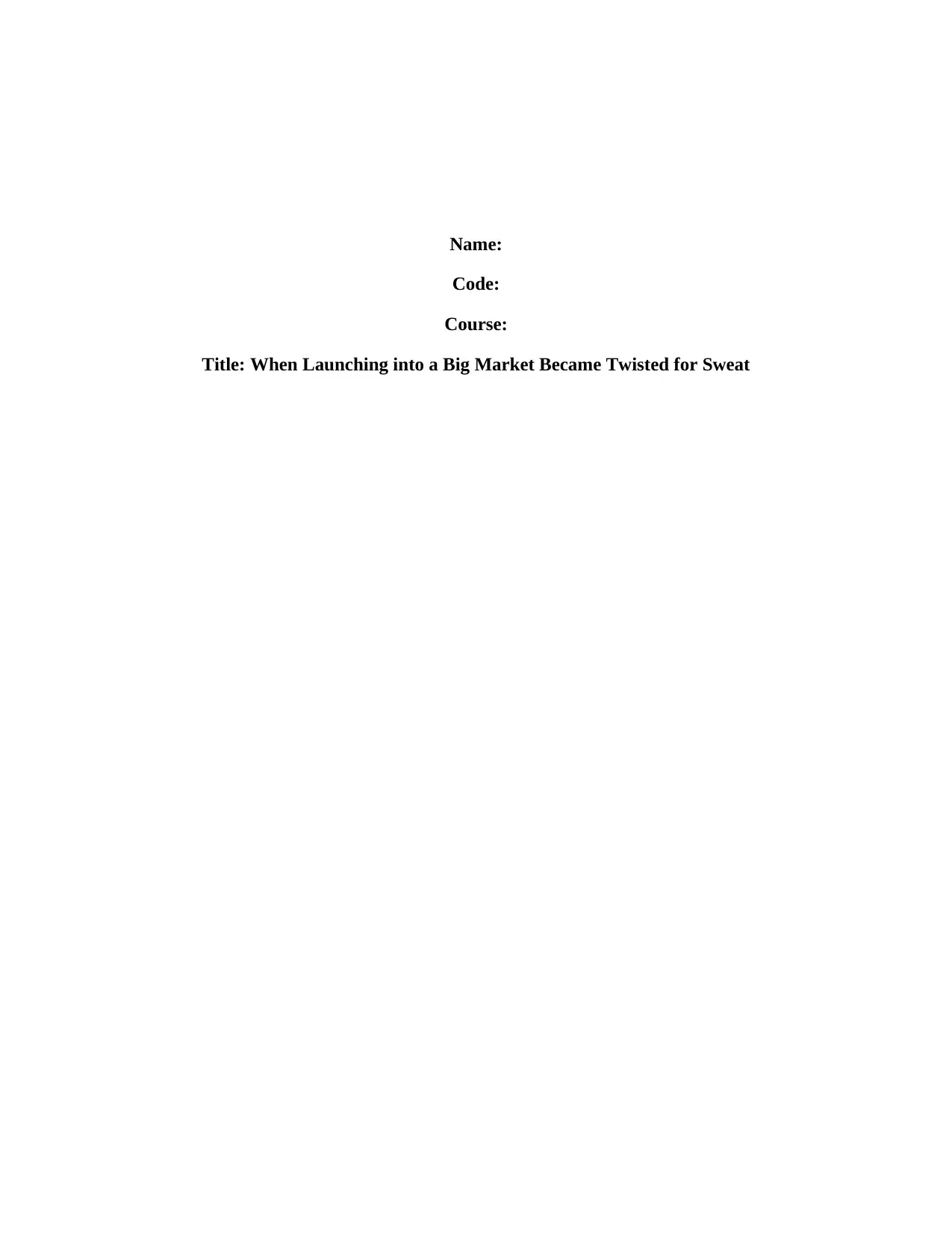
Name:
Code:
Course:
Title: When Launching into a Big Market Became Twisted for Sweat
Code:
Course:
Title: When Launching into a Big Market Became Twisted for Sweat
Secure Best Marks with AI Grader
Need help grading? Try our AI Grader for instant feedback on your assignments.
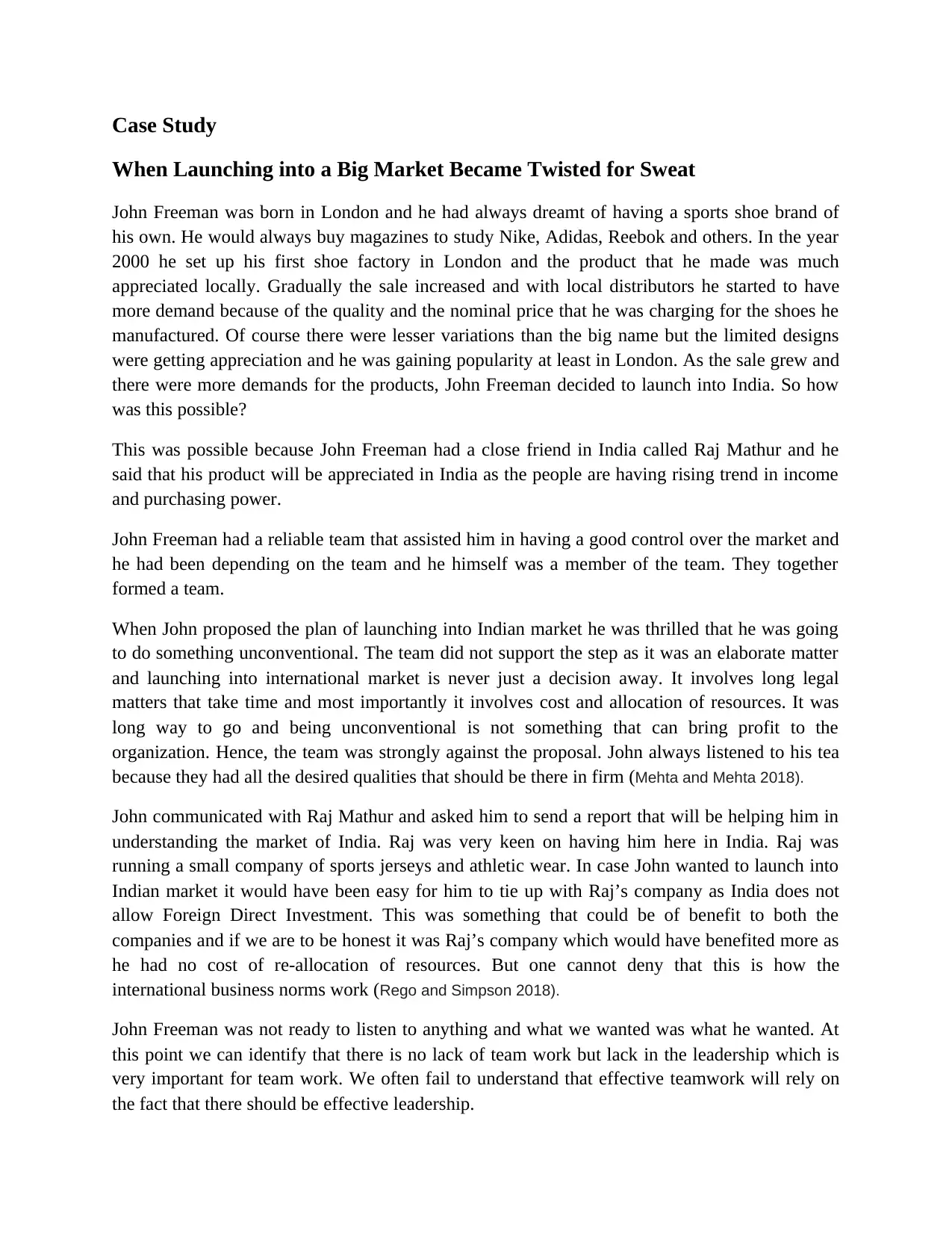
Case Study
When Launching into a Big Market Became Twisted for Sweat
John Freeman was born in London and he had always dreamt of having a sports shoe brand of
his own. He would always buy magazines to study Nike, Adidas, Reebok and others. In the year
2000 he set up his first shoe factory in London and the product that he made was much
appreciated locally. Gradually the sale increased and with local distributors he started to have
more demand because of the quality and the nominal price that he was charging for the shoes he
manufactured. Of course there were lesser variations than the big name but the limited designs
were getting appreciation and he was gaining popularity at least in London. As the sale grew and
there were more demands for the products, John Freeman decided to launch into India. So how
was this possible?
This was possible because John Freeman had a close friend in India called Raj Mathur and he
said that his product will be appreciated in India as the people are having rising trend in income
and purchasing power.
John Freeman had a reliable team that assisted him in having a good control over the market and
he had been depending on the team and he himself was a member of the team. They together
formed a team.
When John proposed the plan of launching into Indian market he was thrilled that he was going
to do something unconventional. The team did not support the step as it was an elaborate matter
and launching into international market is never just a decision away. It involves long legal
matters that take time and most importantly it involves cost and allocation of resources. It was
long way to go and being unconventional is not something that can bring profit to the
organization. Hence, the team was strongly against the proposal. John always listened to his tea
because they had all the desired qualities that should be there in firm (Mehta and Mehta 2018).
John communicated with Raj Mathur and asked him to send a report that will be helping him in
understanding the market of India. Raj was very keen on having him here in India. Raj was
running a small company of sports jerseys and athletic wear. In case John wanted to launch into
Indian market it would have been easy for him to tie up with Raj’s company as India does not
allow Foreign Direct Investment. This was something that could be of benefit to both the
companies and if we are to be honest it was Raj’s company which would have benefited more as
he had no cost of re-allocation of resources. But one cannot deny that this is how the
international business norms work (Rego and Simpson 2018).
John Freeman was not ready to listen to anything and what we wanted was what he wanted. At
this point we can identify that there is no lack of team work but lack in the leadership which is
very important for team work. We often fail to understand that effective teamwork will rely on
the fact that there should be effective leadership.
When Launching into a Big Market Became Twisted for Sweat
John Freeman was born in London and he had always dreamt of having a sports shoe brand of
his own. He would always buy magazines to study Nike, Adidas, Reebok and others. In the year
2000 he set up his first shoe factory in London and the product that he made was much
appreciated locally. Gradually the sale increased and with local distributors he started to have
more demand because of the quality and the nominal price that he was charging for the shoes he
manufactured. Of course there were lesser variations than the big name but the limited designs
were getting appreciation and he was gaining popularity at least in London. As the sale grew and
there were more demands for the products, John Freeman decided to launch into India. So how
was this possible?
This was possible because John Freeman had a close friend in India called Raj Mathur and he
said that his product will be appreciated in India as the people are having rising trend in income
and purchasing power.
John Freeman had a reliable team that assisted him in having a good control over the market and
he had been depending on the team and he himself was a member of the team. They together
formed a team.
When John proposed the plan of launching into Indian market he was thrilled that he was going
to do something unconventional. The team did not support the step as it was an elaborate matter
and launching into international market is never just a decision away. It involves long legal
matters that take time and most importantly it involves cost and allocation of resources. It was
long way to go and being unconventional is not something that can bring profit to the
organization. Hence, the team was strongly against the proposal. John always listened to his tea
because they had all the desired qualities that should be there in firm (Mehta and Mehta 2018).
John communicated with Raj Mathur and asked him to send a report that will be helping him in
understanding the market of India. Raj was very keen on having him here in India. Raj was
running a small company of sports jerseys and athletic wear. In case John wanted to launch into
Indian market it would have been easy for him to tie up with Raj’s company as India does not
allow Foreign Direct Investment. This was something that could be of benefit to both the
companies and if we are to be honest it was Raj’s company which would have benefited more as
he had no cost of re-allocation of resources. But one cannot deny that this is how the
international business norms work (Rego and Simpson 2018).
John Freeman was not ready to listen to anything and what we wanted was what he wanted. At
this point we can identify that there is no lack of team work but lack in the leadership which is
very important for team work. We often fail to understand that effective teamwork will rely on
the fact that there should be effective leadership.
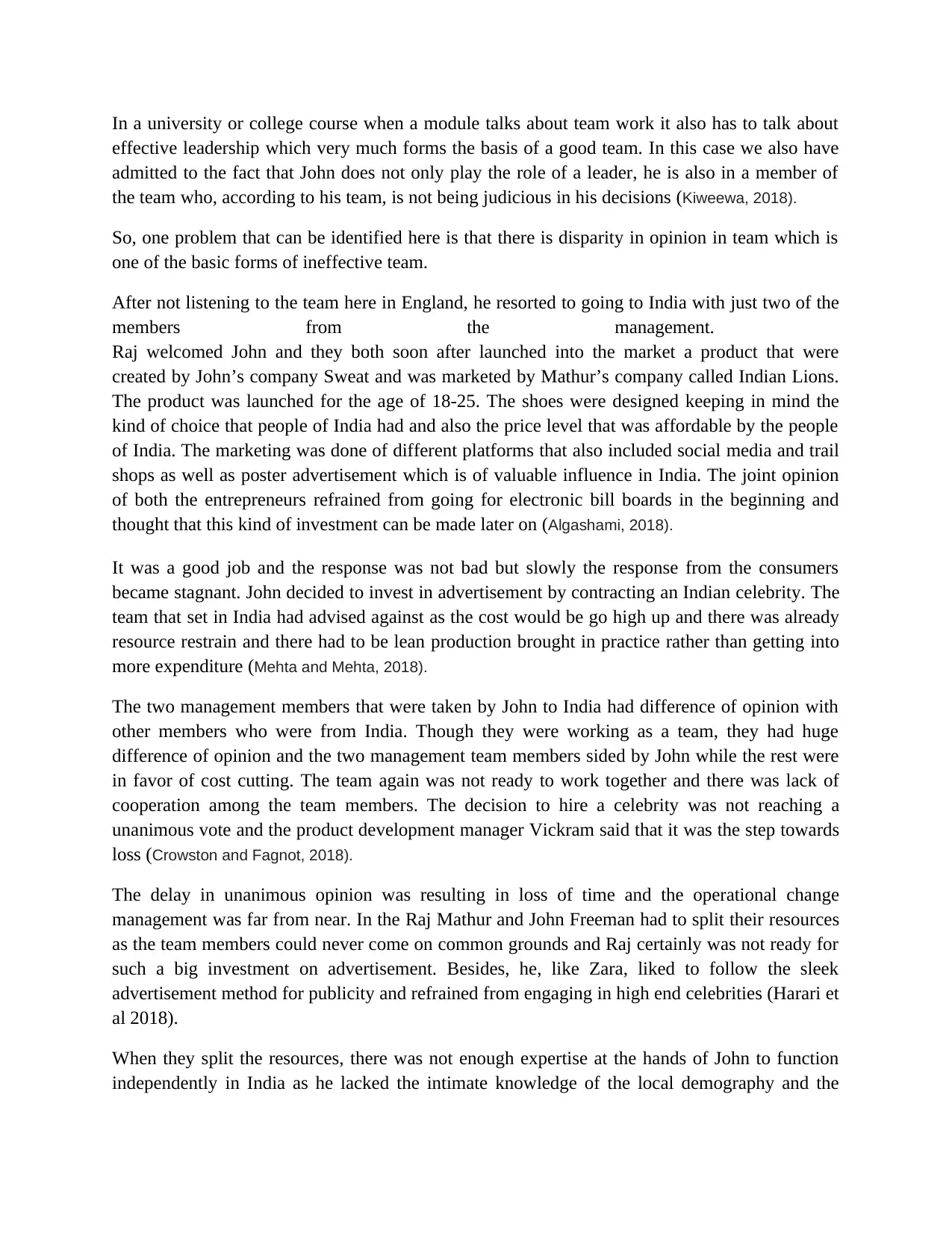
In a university or college course when a module talks about team work it also has to talk about
effective leadership which very much forms the basis of a good team. In this case we also have
admitted to the fact that John does not only play the role of a leader, he is also in a member of
the team who, according to his team, is not being judicious in his decisions (Kiweewa, 2018).
So, one problem that can be identified here is that there is disparity in opinion in team which is
one of the basic forms of ineffective team.
After not listening to the team here in England, he resorted to going to India with just two of the
members from the management.
Raj welcomed John and they both soon after launched into the market a product that were
created by John’s company Sweat and was marketed by Mathur’s company called Indian Lions.
The product was launched for the age of 18-25. The shoes were designed keeping in mind the
kind of choice that people of India had and also the price level that was affordable by the people
of India. The marketing was done of different platforms that also included social media and trail
shops as well as poster advertisement which is of valuable influence in India. The joint opinion
of both the entrepreneurs refrained from going for electronic bill boards in the beginning and
thought that this kind of investment can be made later on (Algashami, 2018).
It was a good job and the response was not bad but slowly the response from the consumers
became stagnant. John decided to invest in advertisement by contracting an Indian celebrity. The
team that set in India had advised against as the cost would be go high up and there was already
resource restrain and there had to be lean production brought in practice rather than getting into
more expenditure (Mehta and Mehta, 2018).
The two management members that were taken by John to India had difference of opinion with
other members who were from India. Though they were working as a team, they had huge
difference of opinion and the two management team members sided by John while the rest were
in favor of cost cutting. The team again was not ready to work together and there was lack of
cooperation among the team members. The decision to hire a celebrity was not reaching a
unanimous vote and the product development manager Vickram said that it was the step towards
loss (Crowston and Fagnot, 2018).
The delay in unanimous opinion was resulting in loss of time and the operational change
management was far from near. In the Raj Mathur and John Freeman had to split their resources
as the team members could never come on common grounds and Raj certainly was not ready for
such a big investment on advertisement. Besides, he, like Zara, liked to follow the sleek
advertisement method for publicity and refrained from engaging in high end celebrities (Harari et
al 2018).
When they split the resources, there was not enough expertise at the hands of John to function
independently in India as he lacked the intimate knowledge of the local demography and the
effective leadership which very much forms the basis of a good team. In this case we also have
admitted to the fact that John does not only play the role of a leader, he is also in a member of
the team who, according to his team, is not being judicious in his decisions (Kiweewa, 2018).
So, one problem that can be identified here is that there is disparity in opinion in team which is
one of the basic forms of ineffective team.
After not listening to the team here in England, he resorted to going to India with just two of the
members from the management.
Raj welcomed John and they both soon after launched into the market a product that were
created by John’s company Sweat and was marketed by Mathur’s company called Indian Lions.
The product was launched for the age of 18-25. The shoes were designed keeping in mind the
kind of choice that people of India had and also the price level that was affordable by the people
of India. The marketing was done of different platforms that also included social media and trail
shops as well as poster advertisement which is of valuable influence in India. The joint opinion
of both the entrepreneurs refrained from going for electronic bill boards in the beginning and
thought that this kind of investment can be made later on (Algashami, 2018).
It was a good job and the response was not bad but slowly the response from the consumers
became stagnant. John decided to invest in advertisement by contracting an Indian celebrity. The
team that set in India had advised against as the cost would be go high up and there was already
resource restrain and there had to be lean production brought in practice rather than getting into
more expenditure (Mehta and Mehta, 2018).
The two management members that were taken by John to India had difference of opinion with
other members who were from India. Though they were working as a team, they had huge
difference of opinion and the two management team members sided by John while the rest were
in favor of cost cutting. The team again was not ready to work together and there was lack of
cooperation among the team members. The decision to hire a celebrity was not reaching a
unanimous vote and the product development manager Vickram said that it was the step towards
loss (Crowston and Fagnot, 2018).
The delay in unanimous opinion was resulting in loss of time and the operational change
management was far from near. In the Raj Mathur and John Freeman had to split their resources
as the team members could never come on common grounds and Raj certainly was not ready for
such a big investment on advertisement. Besides, he, like Zara, liked to follow the sleek
advertisement method for publicity and refrained from engaging in high end celebrities (Harari et
al 2018).
When they split the resources, there was not enough expertise at the hands of John to function
independently in India as he lacked the intimate knowledge of the local demography and the
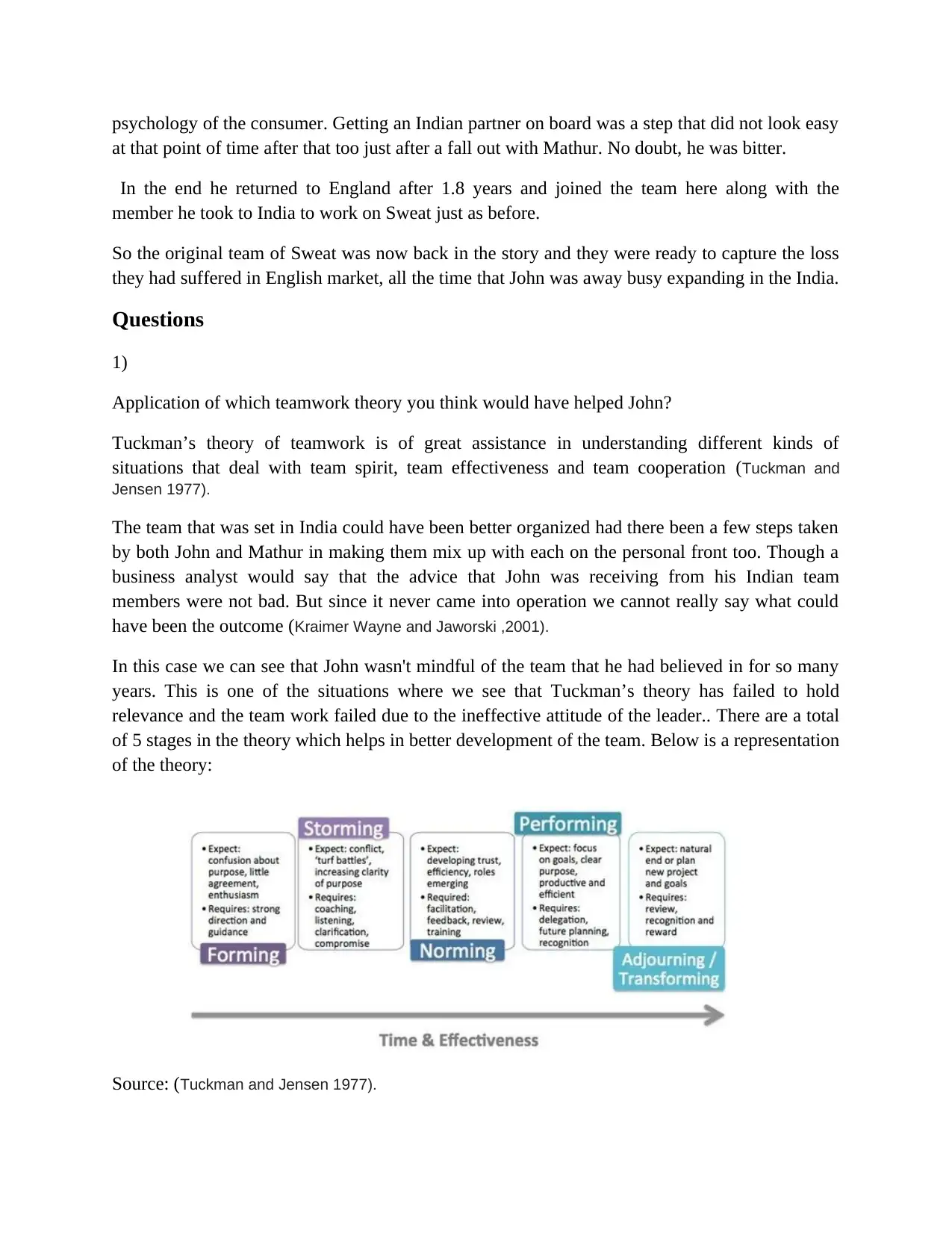
psychology of the consumer. Getting an Indian partner on board was a step that did not look easy
at that point of time after that too just after a fall out with Mathur. No doubt, he was bitter.
In the end he returned to England after 1.8 years and joined the team here along with the
member he took to India to work on Sweat just as before.
So the original team of Sweat was now back in the story and they were ready to capture the loss
they had suffered in English market, all the time that John was away busy expanding in the India.
Questions
1)
Application of which teamwork theory you think would have helped John?
Tuckman’s theory of teamwork is of great assistance in understanding different kinds of
situations that deal with team spirit, team effectiveness and team cooperation (Tuckman and
Jensen 1977).
The team that was set in India could have been better organized had there been a few steps taken
by both John and Mathur in making them mix up with each on the personal front too. Though a
business analyst would say that the advice that John was receiving from his Indian team
members were not bad. But since it never came into operation we cannot really say what could
have been the outcome (Kraimer Wayne and Jaworski ,2001).
In this case we can see that John wasn't mindful of the team that he had believed in for so many
years. This is one of the situations where we see that Tuckman’s theory has failed to hold
relevance and the team work failed due to the ineffective attitude of the leader.. There are a total
of 5 stages in the theory which helps in better development of the team. Below is a representation
of the theory:
Source: (Tuckman and Jensen 1977).
at that point of time after that too just after a fall out with Mathur. No doubt, he was bitter.
In the end he returned to England after 1.8 years and joined the team here along with the
member he took to India to work on Sweat just as before.
So the original team of Sweat was now back in the story and they were ready to capture the loss
they had suffered in English market, all the time that John was away busy expanding in the India.
Questions
1)
Application of which teamwork theory you think would have helped John?
Tuckman’s theory of teamwork is of great assistance in understanding different kinds of
situations that deal with team spirit, team effectiveness and team cooperation (Tuckman and
Jensen 1977).
The team that was set in India could have been better organized had there been a few steps taken
by both John and Mathur in making them mix up with each on the personal front too. Though a
business analyst would say that the advice that John was receiving from his Indian team
members were not bad. But since it never came into operation we cannot really say what could
have been the outcome (Kraimer Wayne and Jaworski ,2001).
In this case we can see that John wasn't mindful of the team that he had believed in for so many
years. This is one of the situations where we see that Tuckman’s theory has failed to hold
relevance and the team work failed due to the ineffective attitude of the leader.. There are a total
of 5 stages in the theory which helps in better development of the team. Below is a representation
of the theory:
Source: (Tuckman and Jensen 1977).
Secure Best Marks with AI Grader
Need help grading? Try our AI Grader for instant feedback on your assignments.
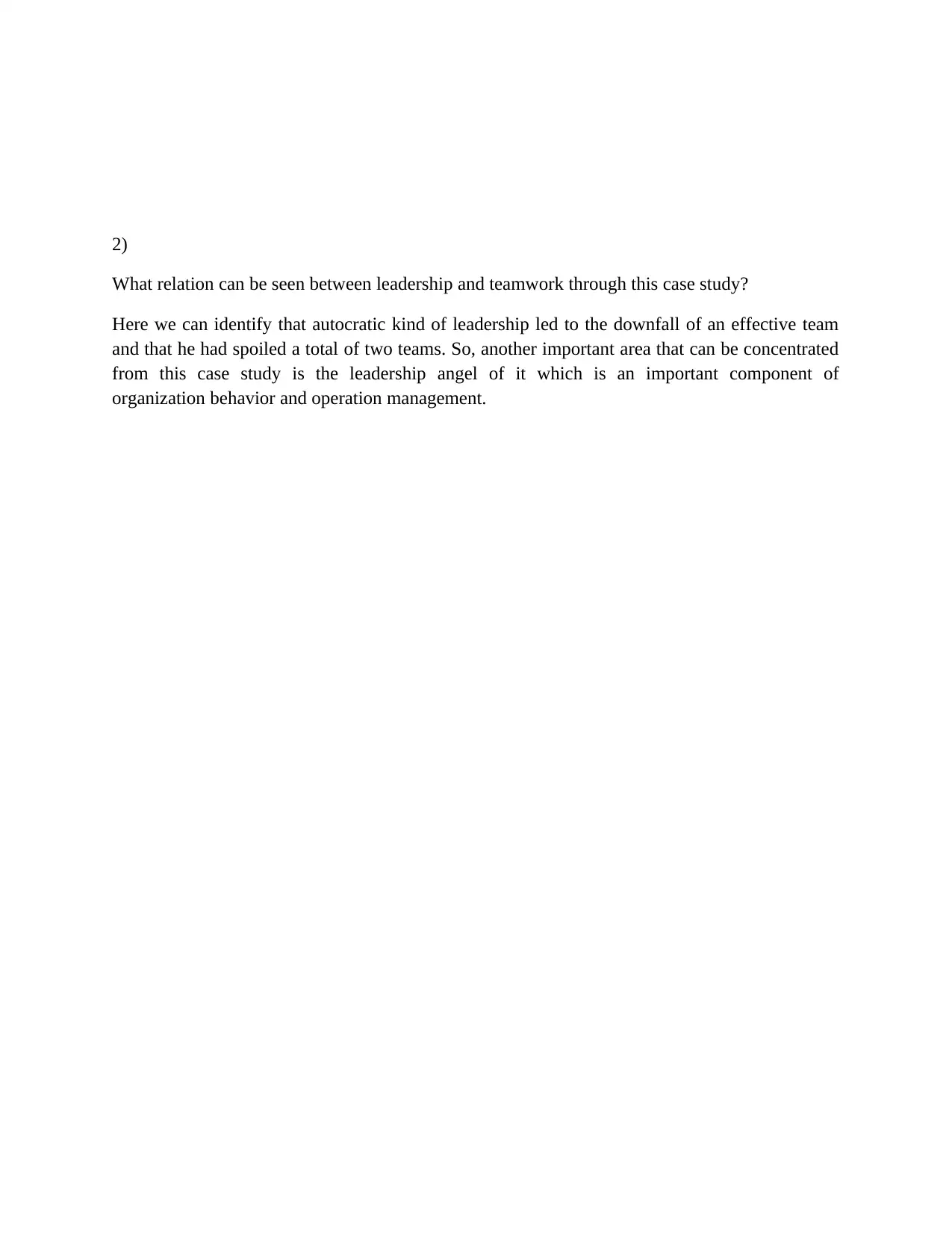
2)
What relation can be seen between leadership and teamwork through this case study?
Here we can identify that autocratic kind of leadership led to the downfall of an effective team
and that he had spoiled a total of two teams. So, another important area that can be concentrated
from this case study is the leadership angel of it which is an important component of
organization behavior and operation management.
What relation can be seen between leadership and teamwork through this case study?
Here we can identify that autocratic kind of leadership led to the downfall of an effective team
and that he had spoiled a total of two teams. So, another important area that can be concentrated
from this case study is the leadership angel of it which is an important component of
organization behavior and operation management.
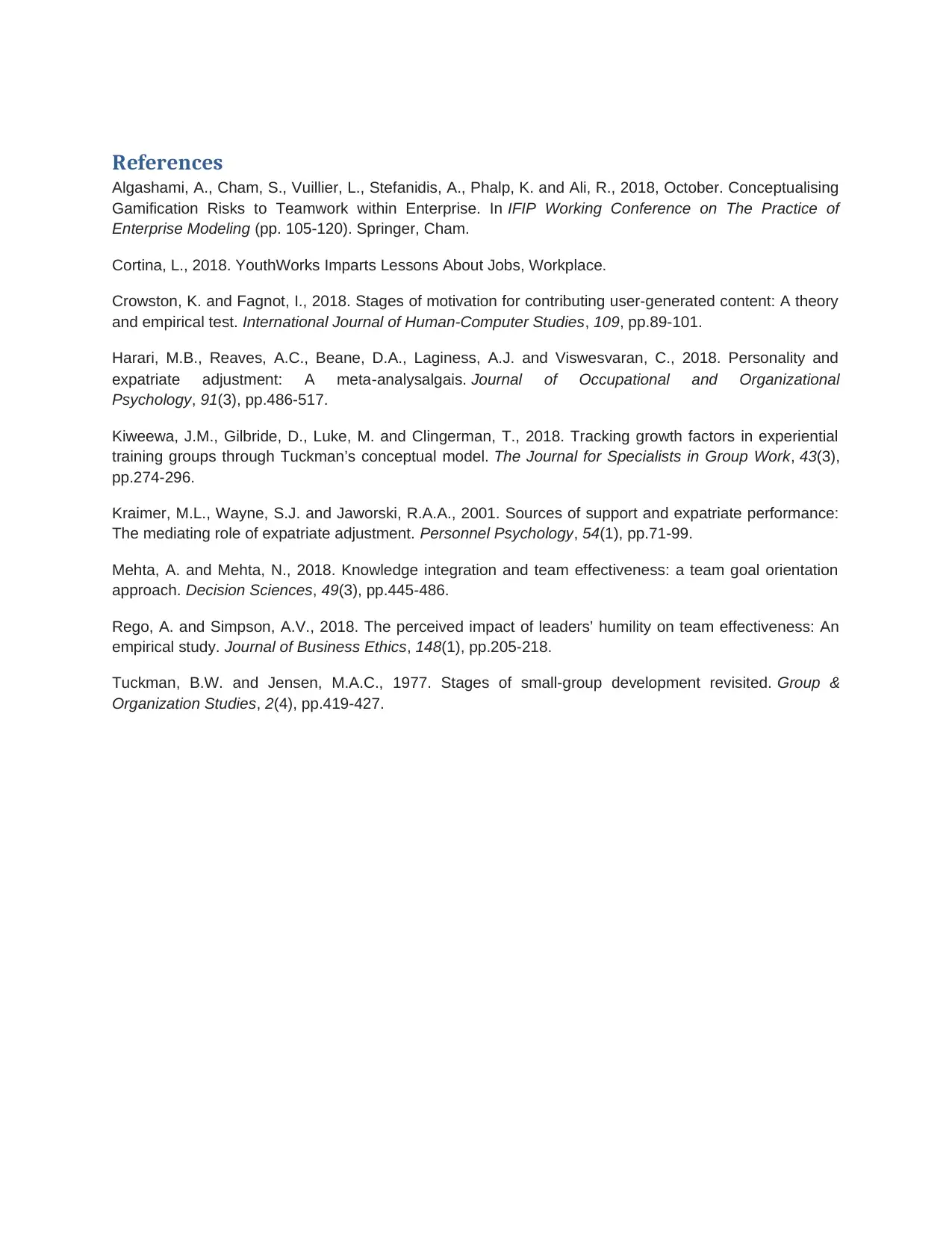
References
Algashami, A., Cham, S., Vuillier, L., Stefanidis, A., Phalp, K. and Ali, R., 2018, October. Conceptualising
Gamification Risks to Teamwork within Enterprise. In IFIP Working Conference on The Practice of
Enterprise Modeling (pp. 105-120). Springer, Cham.
Cortina, L., 2018. YouthWorks Imparts Lessons About Jobs, Workplace.
Crowston, K. and Fagnot, I., 2018. Stages of motivation for contributing user-generated content: A theory
and empirical test. International Journal of Human-Computer Studies, 109, pp.89-101.
Harari, M.B., Reaves, A.C., Beane, D.A., Laginess, A.J. and Viswesvaran, C., 2018. Personality and
expatriate adjustment: A meta‐analysalgais. Journal of Occupational and Organizational
Psychology, 91(3), pp.486-517.
Kiweewa, J.M., Gilbride, D., Luke, M. and Clingerman, T., 2018. Tracking growth factors in experiential
training groups through Tuckman’s conceptual model. The Journal for Specialists in Group Work, 43(3),
pp.274-296.
Kraimer, M.L., Wayne, S.J. and Jaworski, R.A.A., 2001. Sources of support and expatriate performance:
The mediating role of expatriate adjustment. Personnel Psychology, 54(1), pp.71-99.
Mehta, A. and Mehta, N., 2018. Knowledge integration and team effectiveness: a team goal orientation
approach. Decision Sciences, 49(3), pp.445-486.
Rego, A. and Simpson, A.V., 2018. The perceived impact of leaders’ humility on team effectiveness: An
empirical study. Journal of Business Ethics, 148(1), pp.205-218.
Tuckman, B.W. and Jensen, M.A.C., 1977. Stages of small-group development revisited. Group &
Organization Studies, 2(4), pp.419-427.
Algashami, A., Cham, S., Vuillier, L., Stefanidis, A., Phalp, K. and Ali, R., 2018, October. Conceptualising
Gamification Risks to Teamwork within Enterprise. In IFIP Working Conference on The Practice of
Enterprise Modeling (pp. 105-120). Springer, Cham.
Cortina, L., 2018. YouthWorks Imparts Lessons About Jobs, Workplace.
Crowston, K. and Fagnot, I., 2018. Stages of motivation for contributing user-generated content: A theory
and empirical test. International Journal of Human-Computer Studies, 109, pp.89-101.
Harari, M.B., Reaves, A.C., Beane, D.A., Laginess, A.J. and Viswesvaran, C., 2018. Personality and
expatriate adjustment: A meta‐analysalgais. Journal of Occupational and Organizational
Psychology, 91(3), pp.486-517.
Kiweewa, J.M., Gilbride, D., Luke, M. and Clingerman, T., 2018. Tracking growth factors in experiential
training groups through Tuckman’s conceptual model. The Journal for Specialists in Group Work, 43(3),
pp.274-296.
Kraimer, M.L., Wayne, S.J. and Jaworski, R.A.A., 2001. Sources of support and expatriate performance:
The mediating role of expatriate adjustment. Personnel Psychology, 54(1), pp.71-99.
Mehta, A. and Mehta, N., 2018. Knowledge integration and team effectiveness: a team goal orientation
approach. Decision Sciences, 49(3), pp.445-486.
Rego, A. and Simpson, A.V., 2018. The perceived impact of leaders’ humility on team effectiveness: An
empirical study. Journal of Business Ethics, 148(1), pp.205-218.
Tuckman, B.W. and Jensen, M.A.C., 1977. Stages of small-group development revisited. Group &
Organization Studies, 2(4), pp.419-427.
1 out of 6
Your All-in-One AI-Powered Toolkit for Academic Success.
+13062052269
info@desklib.com
Available 24*7 on WhatsApp / Email
![[object Object]](/_next/static/media/star-bottom.7253800d.svg)
Unlock your academic potential
© 2024 | Zucol Services PVT LTD | All rights reserved.